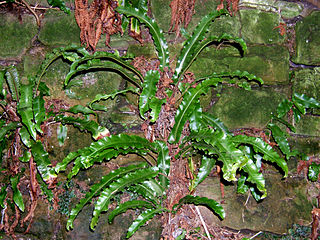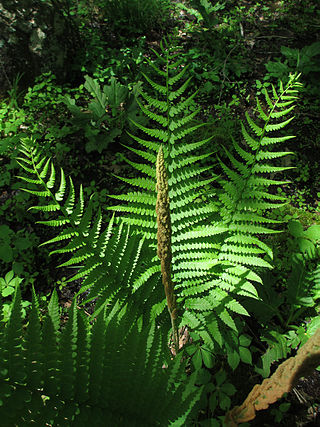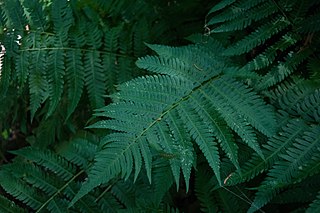This is a list of ferns and other pteridophytes native to the U.S state of Georgia.




This is a list of ferns and other pteridophytes native to the U.S state of Georgia.





The ferns are a group of vascular plants that reproduce via spores and have neither seeds nor flowers. They differ from mosses by being vascular, i.e., having specialized tissues that conduct water and nutrients and in having life cycles in which the branched sporophyte is the dominant phase.

This article relates to the flora of New Zealand, especially indigenous strains. New Zealand's geographical isolation has meant the country has developed a unique variety of native flora. However, human migration has led to the importation of many other plants as well as widespread damage to the indigenous flora, especially after the advent of European colonisation, due to the combined efforts of farmers and specialised societies dedicated to importing European plants & animals.

Perimeter College at Georgia State University is a college of Georgia State University in Atlanta, Georgia. Georgia Perimeter College was originally a public community college founded by an Atlanta area county board of education before merging with Georgia State University in 2016 to create one of the largest universities in the United States with over 50,000 students. The Perimeter College (PC) campuses became components of Georgia State University, still maintaining their own mission, degrees, and admittance requirements, separate from those of the main campus. Before merging with GSU, PC served metro Atlanta with five campus locations and offered more than 40 programs of study, including Arts, Music, Theatre, Nursing, Business Administration, Education, Dental Hygiene, Criminal Justice, and Sign Language Interpreting.
Atlanta History Center is a history museum and research center located in the Buckhead district of Atlanta, Georgia. The Museum was founded in 1926 and currently consists of nine permanent, and several temporary, exhibitions. Atlanta History Center's campus is 33-acres and features historic gardens and houses located on the grounds, including Swan House, Smith Farm, and Wood Family Cabin. Atlanta History Center's Midtown Campus includes the Margaret Mitchell House & Museum. The History Center's research arm, Kenan Research Center, is open by appointment, and provides access to the archival collections. Atlanta History Center holds one of the largest collections of Civil War artifacts in the United States.

Asplenium scolopendrium, commonly known as the hart's-tongue fern, is an evergreen fern in the family Aspleniaceae native to the Northern Hemisphere.

Claytosmunda is a genus of fern. It has only one extant species, Claytosmunda claytoniana, the interrupted fern, native to Eastern Asia, Eastern United States, and Eastern Canada.

Regnellidium is a monotypic genus of ferns of family Marsileaceae.

Athyrium filix-femina, the lady fern or common lady-fern, is a large, feathery species of fern native to temperate Asia, Europe, North Africa, Canada and the US. It is often abundant in damp, shady woodland environments and is often grown for decoration.

Athyrium (lady-fern) is a genus of about 180 species of terrestrial ferns, with a cosmopolitan distribution. It is placed in the family Athyriaceae, in the order Polypodiales. Its genus name is from Greek a- ('without') and Latinized Greek thyreos ('shield'), describing its inconspicuous indusium . The common name "lady fern" refers in particular to the common lady fern, Athyrium filix-femina.

The State Botanical Garden of Georgia is a botanical garden of 313 acres in the United States, with a conservatory operated by the University of Georgia. It is located at 2450 South Milledge Avenue, Athens, Georgia.

Osmundastrum is genus of leptosporangiate ferns in the family Osmundaceae with one living species, Osmundastrum cinnamomeum, the cinnamon fern. It is native to the Americas and eastern Asia, growing in swamps, bogs and moist woodlands.

Dryopteris goldieana, commonly called Goldie's wood fern, or giant wood fern is a fern native to the eastern United States and adjacent areas of Canada, from New Brunswick to Ontario and Georgia. It is the largest native North American species of Dryopteris and along with ostrich fern it is one of the largest ferns in eastern North America. Specimens are known with fronds six feet tall. D. goldieana hybridizes with many other species of Dryopteris and the hybrids tend to be larger than the pure species. It was named by William Hooker in honor of its discoverer, John Goldie. The epithet was originally published as goldiana, but this is regarded as a misspelling to be corrected.

Polypodium virginianum, commonly known as rock polypody, rock cap fern, or common polypody, is a small evergreen species of fern native to the Eastern United States and Canada. It generally grows on rocks and occasionally on tree roots in nature.

Lygodium japonicum is a species of fern that is known by the common names vine-like fern and Japanese climbing fern. It is native to eastern Asia, including Taiwan, Japan, Korea, southeastern Asia, and India, and eastern Australia. The fern is present in the southeastern United States and Puerto Rico as an introduced species.
David Lloyd Jones is an Australian horticultural botanist and the author of many books and papers, especially on Australian orchids.
Kate Alexandra Heffernan is a New Zealand netball international and former cricketer. She represented the New Zealand national netball team at the 2022 Commonwealth Games and the 2023 Netball World Cup. She captained New Zealand at the 2024 Netball Nations Cup. In 2018, she also made two appearances for the New Zealand women's national cricket team.
Hymenophyllum falklandicum, the Falklands filmy fern, is a plant in the fern family Hymenophyllaceae. It is native to southern South America and some subantarctic islands.

Pelazoneuron ovatum, synonym Thelypteris ovata, the ovate marsh fern or ovate maiden fern, is a species of fern in the Thelypteridaceae family. Native to the southeastern United States, this fern can be found in riverbanks and moist canyons. In Georgia it can be found in the Coastal Plain.

Georgia Ponsonby is a New Zealand rugby union player. She represents New Zealand internationally and was a member of their 2021 Rugby World Cup champion squad. She also plays for Matatū in the Super Rugby Aupiki competition and represents Canterbury provincially.
Georgia Ellen Plimmer is a New Zealand cricketer who plays for Wellington Blaze and the New Zealand womne's cricket team as a right-handed batter. In February 2022, she was named in New Zealand's squad for the 2022 Women's Cricket World Cup as a replacement for injured Lauren Down. In May 2022, she was named in New Zealand Women's central contract list for the 2022–23 season.